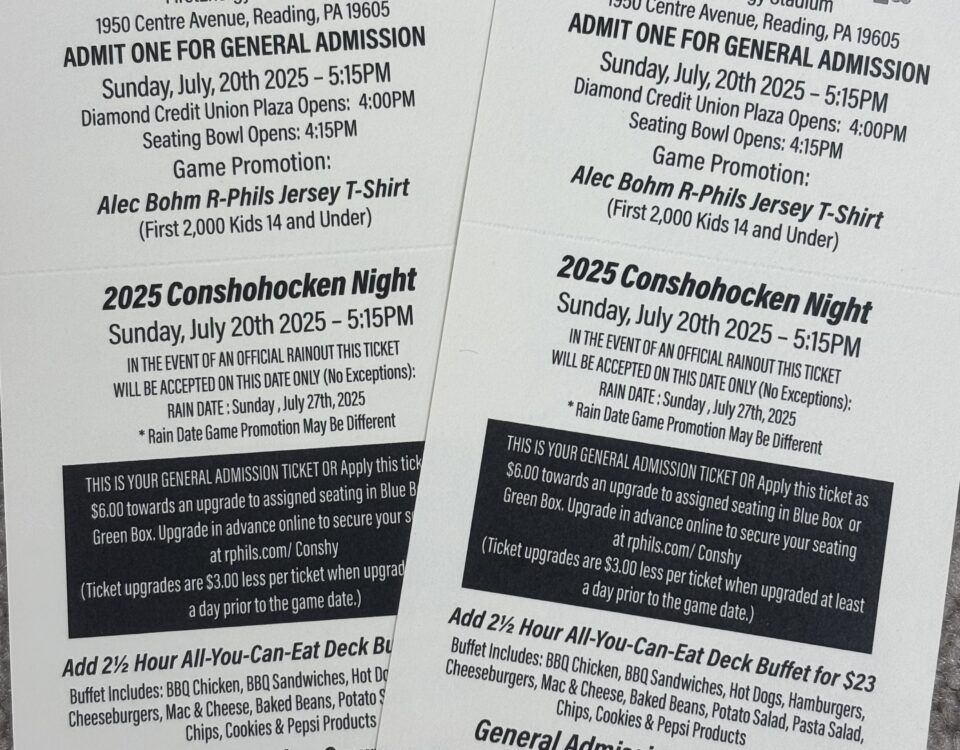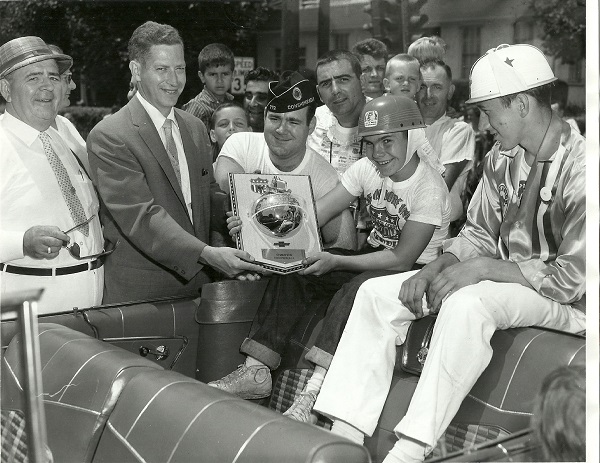
Soap Box Derby , Was Never More Popular Than it was in the 1950’s and 1960’s
June 30, 2020
Have You Tried the Conshy Seafood Company?
July 8, 2020Soap Box Derby the 1960’s Wasn’t All Sex, Drugs and Rock n Roll, It was Sex, Drugs, Rock n Roll and Soap Box Derby

Soap Box
The 1960’s Wasn’t All Sex, Drugs and Rock n’ Roll,
It Was Sex, Drugs, Rock N’ Roll and Soap Box Derby
By Jack Coll
7-4-20
Editor’s Note: With the cancellation of the Conshohocken Annual Fourth of July Soap Box Derby due to the coronavirus I decided to dig deep into my Soap Box Derby files and provide a little history and perhaps a few memories for our Soap Box Derby fans everywhere.
This is the Third in a Series of Conshohocken Soap Box Derby Articles.
If you were a ten or twelve year old kid in 1960 living in the Philadelphia area chances are you were watching one of three channels on television, ABC, NBC, or CBS. And chances were you might have been watching “Our Gal Sal”, Sally Starr, Or Chief Halftown, Gene London, Uncle Pete/Chuck Wagon Pete, or Dick Clark on American Bandstand. Radio was really coming into their own in 1960 with Disc Jockey’s like Doug “Jocko” Henderson, Jerry Blavat, who was a regular dancer on Bandstand when Bob Horn was the host, Blavat was first heard on the radio in 1960. In 1956 we heard “Hyski-O-Roonie-McVouty-o-Zoot”, better known as Hy Lit and by 1960 Hyski was just hitting his stride and Joe “The Rockin’ Bird” Niagara was talking up the hits, although I think he might have left Philly in 1960 for a time before returning.
The 1960’s decade began with music on the radio like “The Twist” by Chubby Checker, who can be seen around town as he’s had his office here for nearly 30 years, there were the Drifters, Elvis, Every Brothers, Ray Charles, and Jimmy Dean, and certainly you remember “Big John.” Then there was Dion, Ricky Nelson, The Tokens and Marvelettes.
By the end of the 1960’s decade we had The Doors, The Rascals, Otis Redding, Marvin Gaye, The Monkees, and Zager & Evans with “In The Year 2525.” In-between we had the Rolling Stones, Led Zeppelin, Motown, The Beatles, More Beatles, Beach Boys, Four Seasons and so-many more.
In Conshohocken Robert Burt, Director of the local Soap Box Derby Race was busy preparing more than 50 entrants for the 9th annual Fourth of July race. The 9th annual race represents when Conshohocken became affiliated with the All American Soap Box Derby Race in 1952.
By 1960 the official All American Soap Box Race was a world-wide event helping to shape the character of thousands of boys bringing communities together with its thousands of volunteers. In Conshohocken Soap Box Derby racing was more popular than ever. A number of the Conshohocken participants included Billy Mellon, Stanley Thomas Jr., Charles Leonard, Paul Donovan, Joel Sukalski, Joe Neve, Mike DePalma, Ronnie Schmoll, Gary Hanna, Jimmy Doughtery, Ronnie Clemens, Richard Racich, Wayne Sibole, Bobby Carr, Billy McCloskey, Billy Donovan, Eddie Moore, Francis Shaw, and a handful of others. The 1960 race also had a contingent of boys from Swedesburg.

When the race was over 14 year old Jimmy Doughtery bested the rest of the field becoming Conshohocken’s ninth official champion. It was an extremely exciting time in the Doughtery household as Jimmy’s brother Matt had raced for three years and his other brother George raced for two years, this was Jimmy’s third year of racing. Jimmy celebrated with the entire Washington Fire Company members as his car was sponsored by the Washies. Doughtery was all smiles when he was driven in a convertible in the parade held in West Conshohocken led by the screaming sirens of the Washies.
Once again the champ was flown out to Akron where the official Soap Box Derby committee greeted him at the airport where he boarded a handsome new convertible and a police escort led him to the Mayflower Hotel with sirens screaming all the way. A high school band greeted him at the hotel along with his travel companions Edward Moore, co-sponsor of the Fourth of July event, Edward F. 3rd, and Mark Moore, along with Joseph Ryan, representative of the American Legion, also co-sponsor of the Fourth. While in Akron the Champ rubbed shoulders throughout the week with Prize-fighter Jack Dempsey, William Boyd, star of “Hopalong Cassidy,” Indianapolis “500” winner Wilbur Shaw, and Jimmy Stewart.
As most of us know Jimmy Doughtery went on to become a Conshohocken police officer and Detective, before becoming the borough Chief of Police for many years.
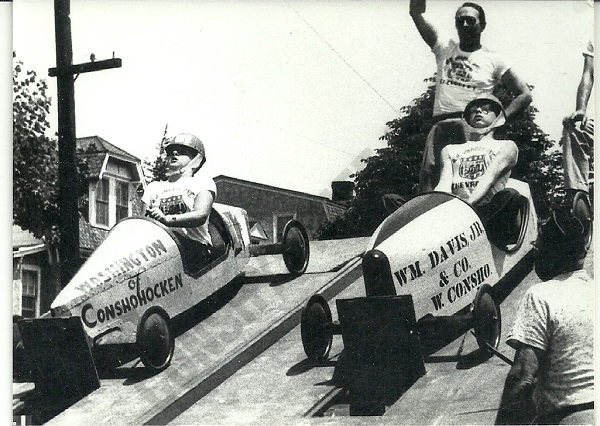
In 1961 the Conshohocken Recorder headline said it all, “Split Second Crossing Of Finishing Line Makes William McCloskey Derby Champ.” McCloskey had lost a year earlier to Jim Doughtery by about ten inches, in his victory he raced in the Class “A” Division and beat Richard and Joseph Galie, Stan Noporski and Joseph Onufer to enter the finals in his V. F. W. sponsored car. This was William’s third race and barley nosed out Wayne Sibole for the championship.
In 1962 it was Robert Landy standing in the winner’s circle when the race ended and in 1963 twelve year old John Koniewicz of Cedar Heights was Conshohocken’s champion.
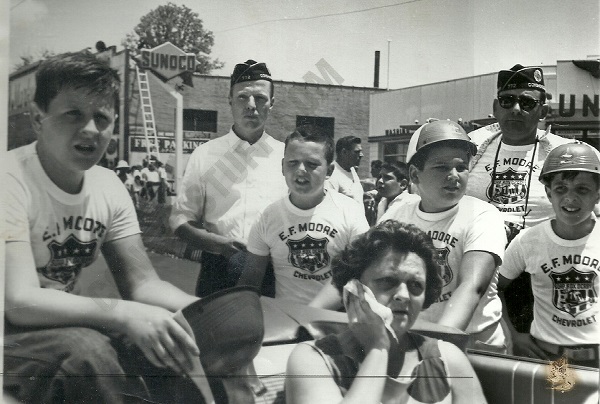

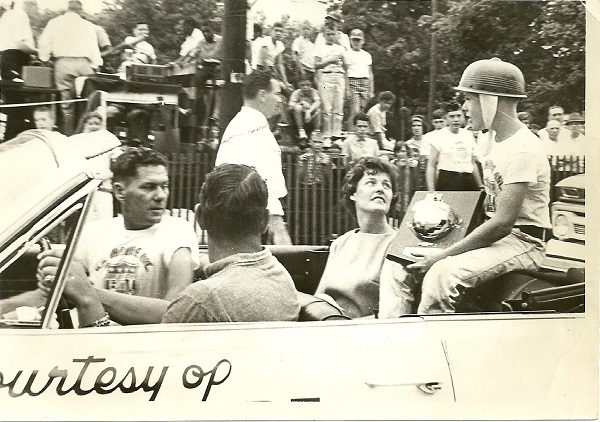

1964 was the beginning of a local soap box derby era, Paul Schwartz of 13th Avenue, a life-long carpenter built a winning car for his son Stephen, Mr. Schwartz also had a helping hand in constructing a winning car for Mike Dennis, (1966) son of long time derby director Mickey Dennis, Jerry Brady’s winning car in 1967, Ace Marinari, the 1968 champ and Jimmy Harper, the 1969 champion, in Soap Box Derby circles it was an era known as the “13th Avenue Dynasty.”
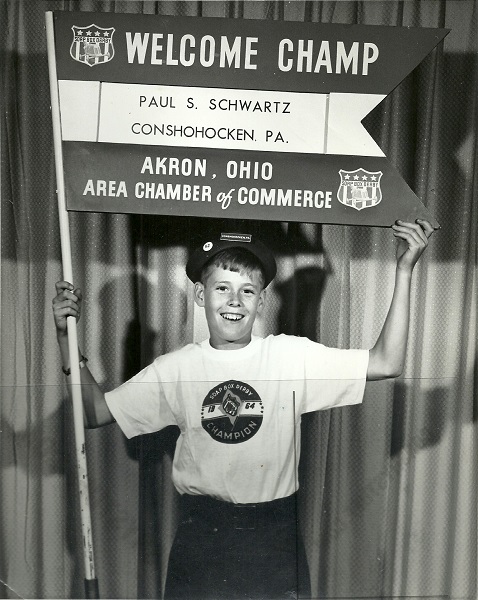
Paul also served as a soap box derby committeeman for more than seven years as a clinic director. Stephen won an extremely exciting race after finishing in a dead heat with 12 year old James Koniewicz, brother of the 1963 champ Stephen won the second race by three feet for the championship.
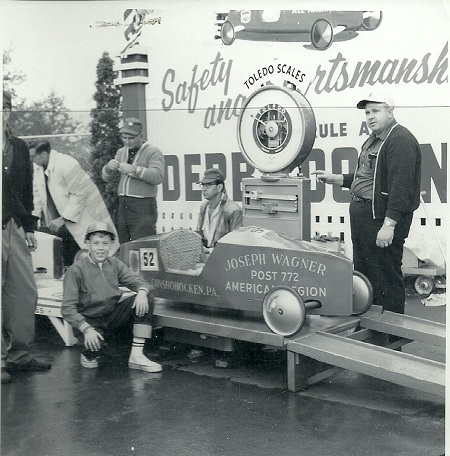
Stephen had finished in third place in 1963 and had won several races in 1962 before getting knocked out as Robert Landy won the championship. Stephen had beat out 44 other racers in 1964 but the Recorder reported that hundreds of spectators enjoyed the race, just two years earlier it had been reported that 7,500 spectators attended the race. The crowds of the 1950’s seemed to be disappearing.

In 1965 Walter Koniewicz beat out 48 other drivers including his older brother James, 13, who had been the runner-up a year earlier. Walter beat William Barber in the final heat of the race.
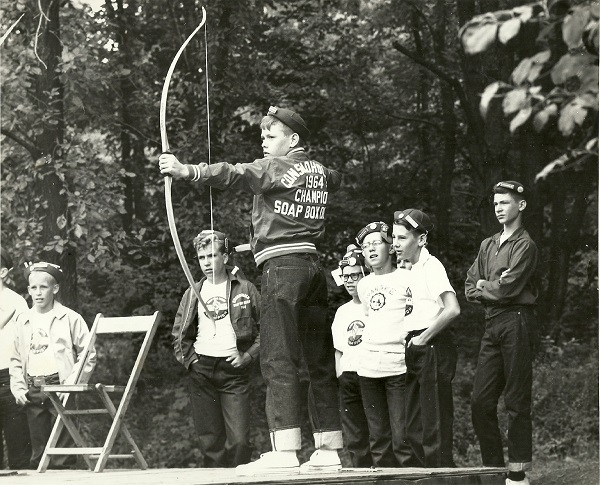
In 1966 Mickey Dennis built his son Mike a car with visions of him racing for several years but Mike won the race beating out Jerry Brady who would become the 1967 champion. I talked to Mike years later and he had nothing but praise for the organizations that had sponsored and ran the race for years. Mike noted “it’s no secret why Conshohocken runs one of the finest races in the country year-in and year-out.” He went on to mention the Conshohocken Ambucs, the Knights of Columbus and the American Legion Post. Mike pointed out the Moore family, “If it wasn’t for the Moore family, there really wouldn’t be much of a race in Conshohocken today,” reflecting back on Eddie and William Moore. In a 1989 interview Mike pointed out Whitey Nasielski, Ray Tomczak, Billy Hayes, Lou Nicolia, Bobby Wood, George Rodenbaugh and countless others.
In 1967 West Conshohocken resident Gerald Brady won the championship and the right to represent Conshohocken on the national stage in Akron, Ohio. In 1968 it was Ace Marinari who bested the field of drivers for the championship and in 1969 it was Jimmy Harper.
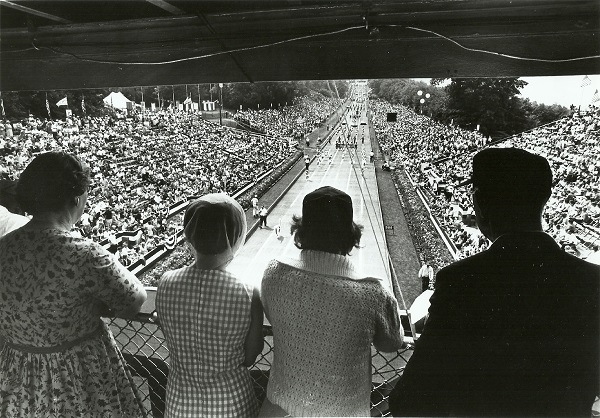
A few of the celebrities appearing in Akron at the All American Race where our local champs got a chance to rub shoulders with during the 1960’s included O. J. Simpson, Hugh O’Brian, Chuck Connors, Dick Clark, Adam West (Batman), Forrest Tucker, Ken Berry, and Larry Storch from “F Troop,” Elizabeth Montgomery, Agnes Moorehead and Dick York of “Bewitched,” Fess Parker, Glen Ford, Frankie Avalon, Lorne Green, Dan Blocker and Michael Landon, Rock Hudson, Paul Lynde, and Paul Anka, just to give you a sample.
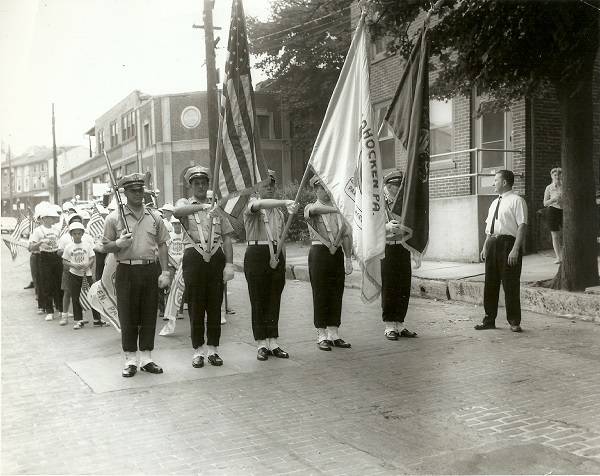
As we turn the page into the 1970’s we noticed troubled times in the country, the United States was fully engaged in the Vietnam War and the U.S.S.R. was performing nuclear tests at Eastern Kazakstan. An explosion aboard Apollo 13 forced an emergency return of the damaged space-craft and its crew. Rock fans throughout the world mourned the deaths of Jimi Hendrix and Janis Joplin. On a lighter note a buck and a half could still get you into the Riant Theatre to see movies like “Patton,” “M*A*S*H,” “Kelly’s Heroes” and “Airport.”
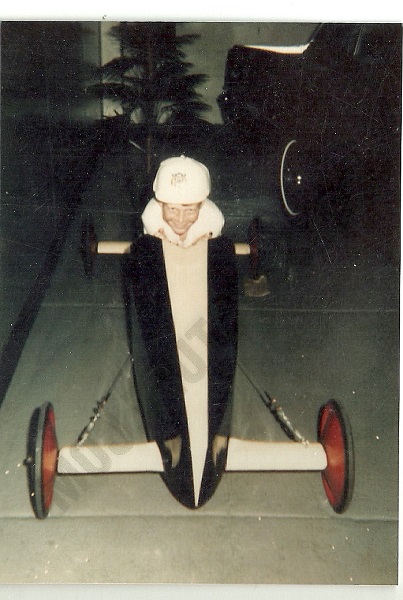
In Conshohocken the 1970 Soap Box Derby was a welcomed diversion from the national and international fears. In 1970 it was the battle of the Schwartz Brothers in the annual Fourth of July event. As the Conshohocken Recorder noted, “Two blue racers-nearly identical-were pushed up the ramps at 8th Avenue and Fayette Street on Saturday just before noon, and the Fourth of July crowd of nearly 4,000 persons was unbelievably silent.
In one car was Mark Schwartz, 11, winner of several heats, trying to capture the Class B
championship of the 1970 Conshohocken Soap Box Derby. In the other car was his brother, Michael James, 12, who missed Class A competition by just two months.
One, two, three!
The cars slid down the ramps and began the agonizingly endless roll down Fayette Street toward Fifth Avenue. At first, Mark seemed ahead. They hit the swell in the street and Mike seemed to move forward. For a long time they were even, but at the last moment Mike edged ahead and won.
He went on to defeat John Maresca of West Eleventh Avenue who had raced against his brother, Anthony. It was the first time in the history of the local derby that brothers had been pitted against each other in a direct final or semifinal contest.”
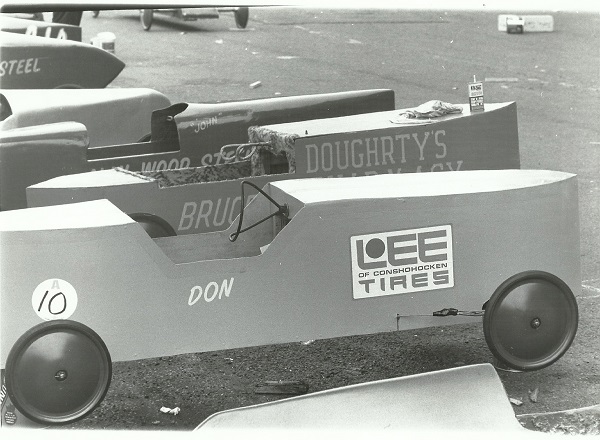
In 1971, 34 racers competed, a few of the contestants included Walter Schank, Joe Donovan, Joe and John Maresca, Dennis Donovan, Charles Smith, Robert Carroll, Larry Licwinko, John DeSantis, Dennis Hufford, Timmy Burns, Bob Evans, Dave Racich, Frank Van Buskirk, Richard DeCerio, Casey Yahner, Eric DiPasquale, Ralph Falconero, Joe Costello, Ted Zoltowski, Joe Malantonio, and Ed Borzelleca just to name a few.
When it was all over Mike Serrbocco of Plymouth Township beat Dennis Donovan to claim the 1971 championship. It almost didn’t happen for Mike as his brakes failed on his third trip down the hill and he crashed into the foam rubber barriers, but officials were able to fix the problem in time for the final run. The parade before the 19th annual Conshohocken Soap Box Derby Race kicked off at the Washington Fire Company, located on West Hector Street. It was led by a parade of past local champions, the 1971 contestants, area firemen and local politicians.
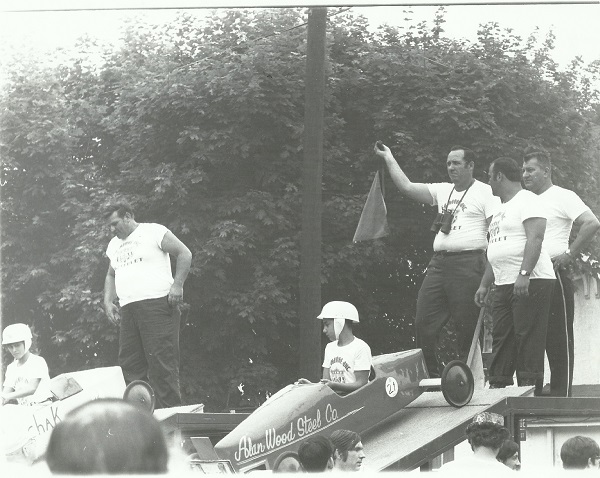
Trophies and other gifts for the racers were handed out later in the week at a special dinner held at the Wagon Wheel Inn on Ridge Pike. Members of the Derby committee in 1971 included Robert Burt, Director; Paul Schwartz, William Nolan, Eddie Moore, Robert Nolan, George Salamone, and Walter Schank. There was a slight down-side to the 1971 race, the Recorder reported that 1500 spectators witnessed the final race compared to 4,000 spectators just a year earlier.
In 1972 John Galleo won the championship, it was also the first time in the 20 year old Conshohocken derby that females were permitted to race. A year later in 1973 Donna Donovan beat out 26 other racers in the Class B field to race for the championship against the Class A winner who happened to be her brother Dennis and eventual winner by a half a car length. Other girls who participated in the 1973 race included Lori Santori, Laura Licwinko and Mary Cunnane. Donna was the first female to reach the championship race in the borough’s local soap box history.
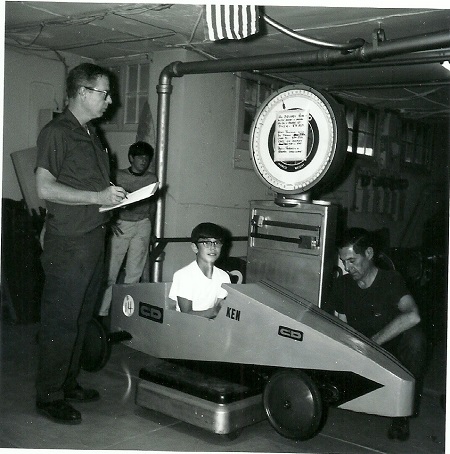
A few of the other participants in the race included Frank Marchak, John Major, Gary Serwatka, Richard McDonough, Walt Schank, Pete Davis, Ralph Falconiero, David Keefe, Don Schwartz, Gary Bowe, Joe Kelly, Rich DeSantis, Harvey McCloskey, Jay Manzi, Michael Yahner, Ernie Neve, David Wilson, Bill Mellon and Bob Moser just to name a few.
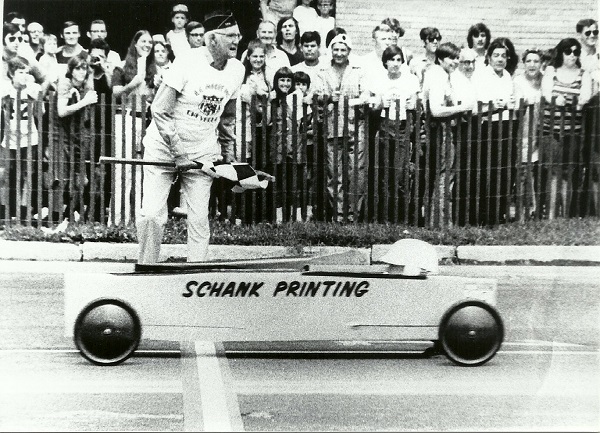
There were 35 racers competing in the annual soap box derby event in 1974, including another brother and sister. In 1973 Dennis Donovan raced against his sister Donna and in 1974 Bobby and Patty Carroll were racing, their Uncle, Thomas Carroll went to Akron, Ohio as a champ back in 1959. When the last race crossed the finish line Ed Meyers of Belmont Hills nosed out Mark Schwartz of 13th Avenue for the championship.
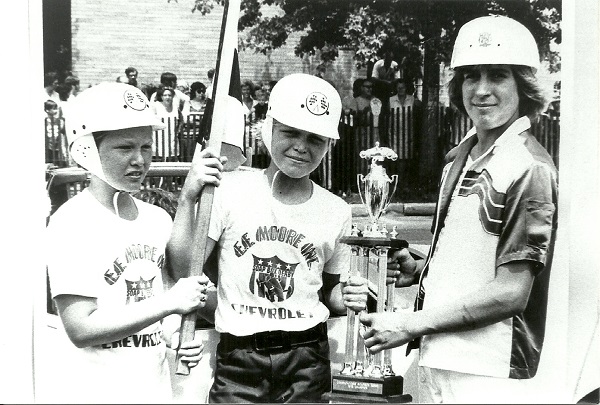
Ed Meyers hit gold in Akron, Ohio when he took a Third Place finish missing the National Championship by about a foot. Meyers was the first Conshohocken racer to place in the top nine at the national event. Meyers made history that day, a Derby Downs record that still stands 46 years later. On Ed’s first run of the day, which was the sixth heat of the race, Ed crossed the finish line in 27.10 seconds, an unheard of time in Akron, it was a track record. His father Ed Meyers Sr. went crazy, in an interview with Ed Sr. nearly forty years ago Ed said, “I knew it when he crossed the finish line that it was a record.”

The crowd held their breath on Ed’s second run of the day as he left the ramp. He was moving on at a pretty good clip when his cockpit door flew open and slowed him down tremendously. Ed still won the heat but it slowed his time to 29.19, thoughts of the cockpit door staying closed would have brought him a much better time. Ed later said that motorcycle daredevil Evil Knevil had just signed his helmet just before the start of the race and he didn’t have time to secure the cockpit latch. Ed’s record run of 27.10 still stands today. A sign at the starting point at the track acknowledges Ed’s record run, visiting racers, parents and fans from Conshohocken can often be seen at the sigh designating Ed’s feat and they can be seen taking pictures with the sign, way to-go Conshy.

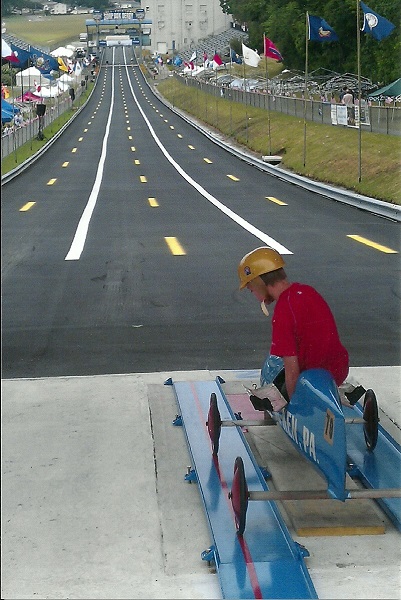
By June 15, 1975 Derby Director Robert Burt had concerns early-on about the diminishing registration for the Fourth of July event as registration for Soap Box cars to participate fell to 21. Burt claimed that it was the lowest car registration in his ten years as Derby Director. Burt publicly pondered if 21 cars in the race justified the effort and expense that goes into the program. Thankfully another ten racers managed to register for the race at the deadline.
Mr. Burt said that 46 cars had participated in 1974, and as many as 65 cars registered a few years prior. Burt also reasoned that perhaps kids have other things to do as racing in the derby eats up a lot of time building he car and they only get one shot down the hill until next year. It was Bob Burt in 1975 who proposed a double elimination race years before it was instituted, giving the drivers more than one trip down the hill.
When race-day came around a total of 35 cars competed for the championship. It was Frank Monastero who nosed out Ernie Neve for the 1975 championship. Neve won a $100.00 savings bond, John McAdam and Louis Nicolai won $50.00 Savings bonds as runner-up in their division.
Along came the Bicentennial year of 1976 and in Conshohocken seven of the 36 soap box racers were female including Kelly Murphy, Mary Murphy, Mary Henik, Jannie Myers, Sue Myers, Sharon McAdam and Karen Kozeniewski.
When the race was over Jannie Myers roared past 27 other racers in her division to become Conshohocken’s first female champion. Jannie’s brother Eddie Myers had won the championship two years earlier and Jannie’s sister Sue Myers also raced but didn’t place. 1976 was the first year for a Junior Division and a Senior Division where two champions would be sent to Akron to represent Conshohocken. Michael Manderacchi won the Junior Division and was also sent to Akron. It wouldn’t be the last time you’ll read Manderacchi name, two years later Michael Manderacchi won the Senior Division and in 1980 Donna Manderacchi became the third female to win a Soap Box Derby championship in Conshohocken. Little sister Kim Manderacchi was a favorite to win the Senior Division a few years later, I forget the details but apparently she was held up in Florida and didn’t make it back in time for the race. (Keep in mind that’s what I had heard at that time but that’s not bible). However her car would go-on to win a championship a few later, that story coming up later.
In 1977 the field of racers had slimmed-down to 27 participants but it didn’t dampen the spirit of the race. A number of 1977 entrants included Lloyd Laskey, Sharon McAdam, Mitchell Kijak, Barbara Wolfe, Andy Alexander, Richard Alexander, Ronnie Nicolai, Billy Lattanze, Scott Long, Joe DeSimone, Doug Dobbs, Bethanne Zummo, Jimmy Gordon, Mary Henik, Denise Bruno, Cody Rodenbaugh, Chris Nasielski, Pat Decerio, Larry Yurick, Michael Manderacchi, and Donna Manderacchi just to name a few of 1977’s racers.
The 1977 race was sponsored by the American Legion Post and the Knights of Columbus and Bob Snyder of Lansdale won the Junior Division and in the Senior Division Ronnie Nicolai barely edged out James Fuller. Nicolai, a Blue Bell resident had a younger brother who would go-on to win the Junior and Senior Division a few years later. Their father Lou Nicolai would go-on to replace Mickey Dennis as the local derby director for a number of years.
In 1978 Conshohocken derby winners were presented their trophies at a cook-out held at the Spring Mill Fire Company. Michael Manderacchi won the Senior Division and Jennifer Snyder went on to win the Junior Division. Jennifer Snyder shocked the Soap Box Derby World when she place second at the National Race in Akron, Ohio. A few years earlier Ed Myers had taken a third place trophy in Akron and Jennifer was the second Conshohocken racer to place in the Top-Nine in Akron. Derby Director Mickey Dennis noted that it was the first trophy award ceremonies held in the form of a picnic but felt it was a very popular move.
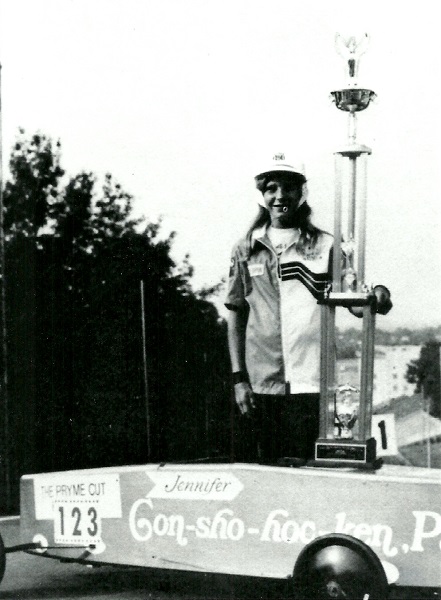
In 1979 a first as far as I know when the rain came half-way through the race and forced a a suspended race until the following day. When the second day of racing was complete Troy Musselman had won the Junior Division and Phyllis Rodenbaugh edged out Chris Nasielski for the Senior Championship.
Throughout the 1960’s and 1970’s Soap Box Derby on a local and national level continued to change, and females were making their mark. It wasn’t until 1971 that girls were officially permitted to race in the Soap Box Derby. Five females participated in the All American Race that year, a year later twenty-seven girls participated and a few of them did quite well. However the first female to drive a racer was Alice Johnson, who had the courage to be the only girl racing in the first soap box derby race in 1933, not only did she race but she almost won-it! Spectators were overheard saying things like what a cute little boy who had finished in second place. As she/he went up to claim his prize and removed her cap, her long golden hair tumbled out. Gasps of surprise were heard as people said aloud, why it’s a girl!
Conshohocken posted three female champions during the 1970’s, but there was a whole lot more to come. See ya in the 1980’s, and Thanks for the Memories.
Photographs above and below include:
1960 Champion Jim Doughtery shows off his trophy following the race.
1960 Still had the wooden high ramps, Jimmy Doughtery can be seen on the left as he went on to win the race.
1960 Winners Circle, Jimmy Doughtery, on the left following his victory along with from left Derby Director Bob Burt, Billy Gordon, Eddie Moore, Victor Orlor, Eddie Moore Sr., and Betty Doughtery, Jim’s mother.
1964 A close finish in the final heat of the day where Stephen Schwartz nosed out his opponent for the championship.
1964 Stephen Schwartz takes a victory lap after winning the 1964 Soap Box Derby Championship. Riding in the car with Stephen is his parents Mr. and Mrs. Paul Schwartz.
1964 Stephen Schwartz poses in his winning car in the back yard of his home along with family members.
1964 Stephen Schwartz arrives in Akron, Ohio for the 1964 All American downhill classic.
1964 Stephen Schwartz weighs in with his car at Derby Downs in Akron, Ohio.
For all the young racers and younger parents I wanted to give you a glimpse of the crowds that the All American Race used to attract, back in the 1950’s and 1960’s crowds of more than 50,00 spectators wasn’t uncommon. The derby camp was filled with activities like boating, fishing, campfires, horse-back riding, swimming and archery,
1964 Thousands of spectators gathered for the Parade of Champions held in downtown Akron every year. Every light post had a banner of a champion with their name and hometown on it. Celebrities would always participate in the parade, in 1964 Lorne Green, Dan Blocker, Michael Landon, Pernell Roberts and as the banner says, Adam West, “Batman.”
1964 Stephen Schwartz at Derby Town Camp showing off his archery skills.
1964 The view from the tower at the finish line, crowds can be seen the entire length of the track.
1965 The Conshohocken Parade of Champions held every year up to that point gathered at the Washington Firehouse on West Hector Street and were led up Fayette Street by members of the American Legion and VFW Post. The parade would make their way up Fayette Street to Seventh Avenue where they would hold opening ceremonies at Conshohocken High school.
1966 The 1966 Champion Mike Dennis shows off his winning drivers form in his car following the race.
Circa 1970’s A view of some of the derby cars in the pits in the mid 1970’s.
Circa 1970’s Life on the starting ramps.
1970 Inspection for the 1970 soap box derby race was held in the basement of the American Legion Post 772. Ken Rozecki, 12, of West 12th Avenue was getting weighted in. Inspectors included Paul Schwartz on the right and Robert Burt Derby Director.
1973 Dennis Donovan crosses the finish line winning the 1973 championship.
1973 Dennis Donovan shows off the championship trophy with his sister Donna standing next to him on the left and (I think) the 1972 champion John Gallo presenting the trophy to Dennis.
1974 Ed Myers Sr., left gives a winning hug to his son Ed Jr., after winning the 1974 race. Meyers went on to post a third place finish in Akron at the All American Race.
2012 (Two Photos) Eddie Myers winning car was dusted off for one more nostalgic run at Derby Downs 38 years after his record setting run.
1978 Jennifer Snyder poses with her trophy after taking a second place finish in Akron Ohio.

